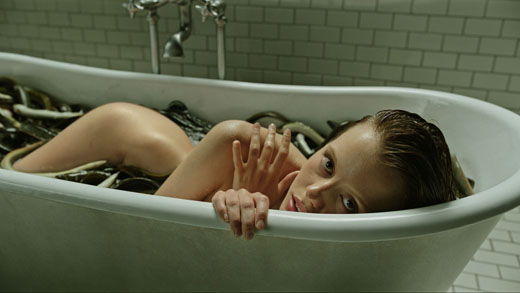Review: A Cure For Wellness (2017)
Gore Verbinski’s latest is a feast for the eyes that invokes the spirit of classic big screen horror, yet ultimately comes up short on the narrative end.
Gore Verbinski’s talent for crafting unique and eyecatching visuals is one that has struck gold with audiences worldwide in many films. From the first three installments of Disney’s Piractes of the Caribbean franchise to the 2002 J-horror remake The Ring, its difficult to argue that Verbinski doesn’t have a sharp eye for making films that make an impact on viewers and on the box office. However, following the disappointing returns of his 2013 Disney produced reimagining of The Lone Ranger with Johnny Depp as Tonto, Verbinski hasn’t made a new film until this one. The question becomes, is a A Cure For Wellness a return to form or the same kind of a muddle that The Lone Ranger was. While a visually arresting film that wears its influences to classic Universal horror and noir on its sleeve, the film loses its way in terms of telling a coherently paced story.
Dale Dehaan plays Lockhart, a ambitious executive for an unnamed corporation. Lockhart is exposed by the company’s crooked board of directors of fudging his numbers, but they offer him a chance for redemption if he goes to the Swiss Alps to retrieve the company’s wayward CEO, a man named Roland Pembroke (played by Buffy the Vampire Slayer alum Harry Groener). Lockhart’s journey to the sanitarium where Pembroke has journeyed to rid himself of this unspoken illness is steeped in film noir and gothic film influences. Upon meeting the director of the sanitarium, a man named Dr. Heinreich Volmer (Jason Isaacs), Lockhart demands that Pembroke be turned over to him to return to New York. They promise to do so within a few hours. However, during that time frame, Lockhart is seemingly injured in a car accident and admitted into the same sanitarium where he agrees to take the treatment that Pembroke is also doing so that he might gain access to the man. Along the way, he meets a girl named Hannah (Mia Goth), who lives at the sanitarium and takes the same medicine she sees Dr. Volmer taking in his office. As the film progresses, we as the audience are left to ask how much of what Lockhart experiences is actually happening.
The big issue with the film is the film being reticent to tell the audience what is going on. Its harmed even moreso by the film’s deliberate pacing, as the film seems to wnat to end various times but Verbinski and co. have not given us anything close to a denouement until the last 20 minutes or so of the film. Unfortunately, these series of reveals only serve to point out the obvious to any astute viewer at that point. Parallels to Universal Monster films are apt here, but what is less obvious is an ill advised incest storyline that makes one wonder how Verbinski got a $40 million budget for this decidedly flawed and unconventionally strange horror film. It would be one thing if it worked (it doesn’t), but it does put on a daring visual. If you enjoyed films like Shudder Island and Sucker Punch by way of Marcus Nispel’s Frankenstein film based on the Dean Koontz version of the character; you’ll find a lot of familiarity in this film. Mia Goth’s performance is one of the few saving graces of the film; though there is some bizarre sexual subtext going around with her “flowering” into a woman and the body politics of choice and sexual agency in the film. However, it becomes almost as frustrating as watching Lost when the end comes and the film doesn’t answer most of the mysteries it sets up and prefers eye candy over narrative as its guiding philosophy.



